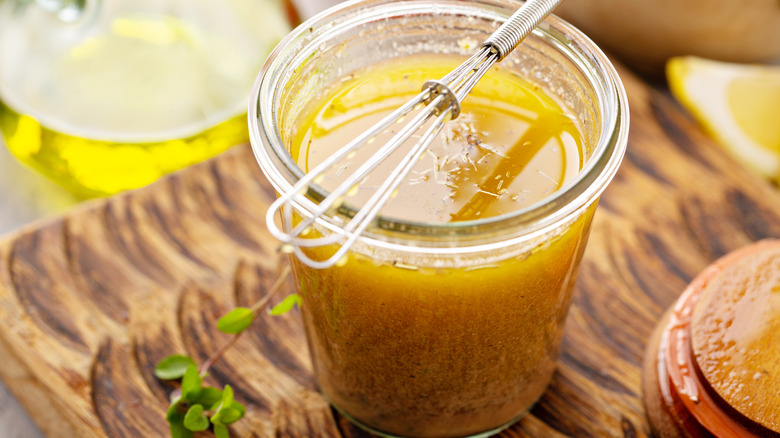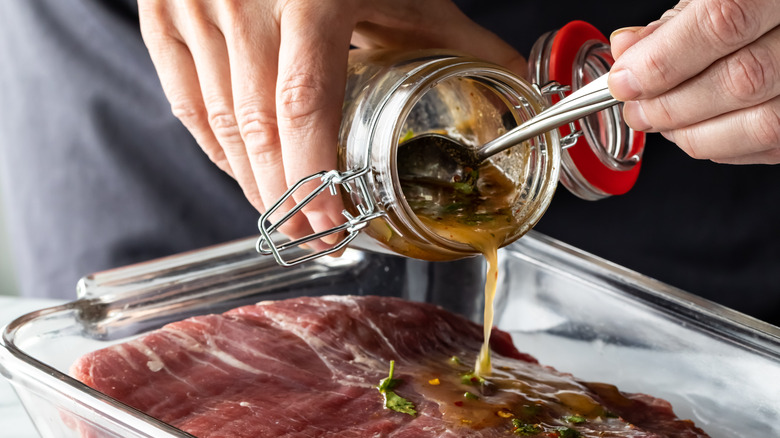The Traditional Italian Marinade For Quick, Tender Steak
The Italians have a way with simple dishes, and you better believe that includes how to marinate a steak. The most famous of Italian steaks, Florentine, is notorious for its exceedingly short ingredient list, often just flavored with salt and pepper or rubbed with a bit of garlic and rosemary. Further south in Sicily and Calabria, they do things a little differently, taking advantage of their bountiful citrus groves to produce a lemony, rustic sauce called salmoriglio. While it has plenty of delicious uses, one of its best pairings is a marinade for steak, where it can quickly turn even a cheap cut of meat into a bright, gourmet dinner.
Salmoriglio involves flavors common to other Mediterranean cuisines like Greek and Spanish, which have influenced the region. It is traditionally just olive oil, lemon juice, salt, water, and oregano, and sometimes parsley is added, depending on the dish being prepared. The name salmoriglio comes from a word meaning "brine," which it can be, for curing things like olives, but it also hints at its use as a marinade. It's a bracingly tart sauce, as a high proportion of it is lemon juice, and it can also be quite salty, depending on your tastes. The water in salmoriglio can even be a splash of seawater if you have it on hand.
How to make salmoriglio
Like a dressing, salmoriglio has a creamy texture because it involves producing an emulsion by mixing together oil, water, and acid. You make it by whisking together olive oil, oregano, and salt with water and lemon juice (though you can nix the water). The oregano can be either fresh or bottled, whether you want the minty flavor or fresh or the deeper herbal taste of dried. You can vary the ingredient ratios to taste, but a standard mix uses a 1/4 cup of lemon juice for every 1/2 cup of olive oil. The water can be roughly equal to the lemon juice, but it can be reduced if you find the sauce too thin. For each 1/2 cup of oil, you can use 2 tablespoons of fresh oregano or 2 teaspoons of dried, and a minced clove of garlic or two before salting everything to taste.
The sauce is normally paired with seafood because fish is a central part of the diet in southern Italy, and the sauce's light taste is thought to complement the fresh catches that can be had in the region. For fish, it can be used as a quick marinade or reduced into a finishing sauce. It can also be set on the table as a condiment, to be spooned over roasted vegetables and salad. But let's focus now on its use with steak specifically.
Lemony salmoriglio is a great pairing for steak
Like its uses for fish, salmoriglio's punchy acidity makes it great company for steak, as either a marinade or a sauce. The high proportion of lemon juice acts as a great tenderizer when used as a marinade, breaking down meat's collagen and proteins. This means it can take a tougher cut like flank steak and tenderize it while also adding plenty of flavor, the same way the lime juice in carne asada does. Just don't let your meat sit too long (more than six hours), as the acidity will eventually turn the meat mushy. Lemon juice and salt are also both flavor enhancers, bringing out the natural tastes of your steak as the marinade permeates through it.
Beyond marinating, salmoriglio works as a simple sauce for steak because it balances it out by adding brightness. Steak's flavor comes from the meaty protein and fat, and the tangy sauce cuts those heavy tastes and adds some more complexity through the contrasting flavors.
Salmoriglio is flavorful, but the clean taste strikes a nice balance between its own lemony, herby notes and letting the steak shine, the same way it does with fish. Like any ideal Italian preparation, it's about emphasizing the natural deliciousness of your centerpiece with minimal distraction, all done with easy, fresh ingredients. And what is more naturally delicious than steak?


